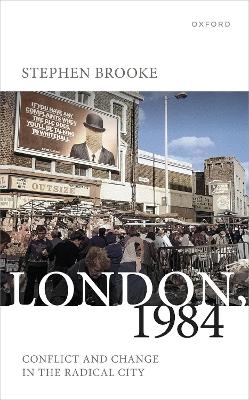
London, 1984
Conflict and Change in the Radical City
Seiten
2024
Oxford University Press (Verlag)
978-0-19-886288-8 (ISBN)
Oxford University Press (Verlag)
978-0-19-886288-8 (ISBN)
London, 1984 examines the history of London during the tumultuous 1980s. Against the backdrop of dramatic political and social change driven by Margaret Thatcher and the Conservative government, it explores the radical politics of the capital, tracing the impact of political and social changes on the lives of ordinary Londoners.
In London in 1984 two very different cities came into conflict, one rooted in radical politics and the other shaped by Margaret Thatcher and the Conservative government. This was a city poised between two eras and identities, remoulded in conflicting ways by social democracy and neoliberalism.
Using a wide array of sources, many of which have never been used before, London, 1984 explores the radical history of the capital in this tumultuous era, from a major anti-apartheid march in central London to an alternative childcare centre in Dalston, from a protest staged on the Thames against Docklands development to tensions on housing estates in the East End and Tottenham around racial violence and policing, from a raid on a gay bookshop in Bloomsbury to the Greater London Council's attempt to build a challenge to Thatcherism from County Hall, Lambeth, and from controversial and well-known historical actors, such as Ken Livingstone and Margaret Thatcher, to the compelling stories of numerous less famous Londoners who also sought to influence the shape and nature of their city. This is a story of struggles within the corridors of power, but it is also one of those on the ground, waged through popular culture and activism, and in daily life.
In so doing, London, 1984 offers a panoramic, timely, and revealing portrait of the city in a pivotal decade in its modern history. These years saw deep problems of racial violence, policing, and poverty, as well as other controversies and struggles—over feminism, gay and lesbian rights, anti-racism, jobs and economic strategy, neoliberalism and the nature of the state, and global issues, such as Apartheid, nuclear weapons, and Northern Ireland. Across these, and the stories of those who lived, shaped, and fought them, we see the roots of London and Britian today.
In London in 1984 two very different cities came into conflict, one rooted in radical politics and the other shaped by Margaret Thatcher and the Conservative government. This was a city poised between two eras and identities, remoulded in conflicting ways by social democracy and neoliberalism.
Using a wide array of sources, many of which have never been used before, London, 1984 explores the radical history of the capital in this tumultuous era, from a major anti-apartheid march in central London to an alternative childcare centre in Dalston, from a protest staged on the Thames against Docklands development to tensions on housing estates in the East End and Tottenham around racial violence and policing, from a raid on a gay bookshop in Bloomsbury to the Greater London Council's attempt to build a challenge to Thatcherism from County Hall, Lambeth, and from controversial and well-known historical actors, such as Ken Livingstone and Margaret Thatcher, to the compelling stories of numerous less famous Londoners who also sought to influence the shape and nature of their city. This is a story of struggles within the corridors of power, but it is also one of those on the ground, waged through popular culture and activism, and in daily life.
In so doing, London, 1984 offers a panoramic, timely, and revealing portrait of the city in a pivotal decade in its modern history. These years saw deep problems of racial violence, policing, and poverty, as well as other controversies and struggles—over feminism, gay and lesbian rights, anti-racism, jobs and economic strategy, neoliberalism and the nature of the state, and global issues, such as Apartheid, nuclear weapons, and Northern Ireland. Across these, and the stories of those who lived, shaped, and fought them, we see the roots of London and Britian today.
Stephen Brooke was educated in Canada and England. He has written widely on socialist politics in twentieth-century Britain and on British photography. He is a Professor of History at York University, Toronto.
Introduction
1: GLC London, 1981-4
2: Anti-Racist Year
3: Capital City? People's Armadas, Pop, and Planning
4: A City for Women?
5: Gay's the Word
6: Dalston Children's Centre
7: The Anti-Apartheid March
8: Lincoln Estate
9: Westminster and Broadwater Farm
Conclusion
Bibliography
Index
| Erscheinungsdatum | 17.02.2024 |
|---|---|
| Zusatzinfo | 12 black and white figures |
| Verlagsort | Oxford |
| Sprache | englisch |
| Maße | 140 x 224 mm |
| Gewicht | 560 g |
| Themenwelt | Geschichte ► Allgemeine Geschichte ► Zeitgeschichte |
| Geisteswissenschaften ► Geschichte ► Regional- / Ländergeschichte | |
| Geschichte ► Teilgebiete der Geschichte ► Kulturgeschichte | |
| ISBN-10 | 0-19-886288-1 / 0198862881 |
| ISBN-13 | 978-0-19-886288-8 / 9780198862888 |
| Zustand | Neuware |
| Informationen gemäß Produktsicherheitsverordnung (GPSR) | |
| Haben Sie eine Frage zum Produkt? |
Mehr entdecken
aus dem Bereich
aus dem Bereich
Schulbuch Klassen 7/8 (G9)
Buch | Hardcover (2015)
Klett (Verlag)
CHF 29,90
Buch | Softcover (2004)
Cornelsen Verlag
CHF 23,90


